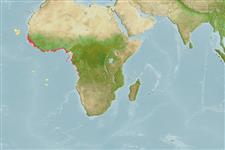Environment: milieu / climate zone / depth range / distribution range
Ecologia
marinhas; Água doce; estuarina associadas(os) a recifes; intervalo de profundidade 0 - 50 m (Ref. 55). Tropical; 34°N - 17°S, 27°W - 14°E (Ref. 55)
Eastern Atlantic: west coast of Africa (Ref. 57393) from Senegal to Congo (Ref. 81653), primarily in the Gulf of Guinea and Cape Verde Islands (Ref. 57393, 81653).
Tamanho / Peso / Idade
Maturity: Lm ? range ? - ? cm
Max length : 80.0 cm TL macho/indeterminado; (Ref. 55); common length : 50.0 cm TL macho/indeterminado; (Ref. 55)
Espinhos dorsais (total) : 10; Raios dorsais moles (total) : 14; Espinhos anais: 3; Raios anais moles: 8. Diagnosis: body stocky (Ref. 57393), relatively deep (Ref. 81653). Head pointed, dorsal profile of forehead abrupt/steep (Ref. 55, 57393, 81653). Eyes large (Ref. 81653). Preorbital/lachrymal bone (very) broad (Ref. 55, 81653). Maxilla extending to about mid-eye level (Ref. 55, 57393, 81653). Vomerine tooth plate triangular with a pronounced, long, postero-median extension (Ref. 57393, 81653). Pectoral fins of adult not reaching level of anus (Ref. 55, 81653). Scales medium-sized and ctenoid (Ref. 57393, 81653). Scale rows on back parallel to lateral line (Ref. 55, 57393, 81653), 5-7 rows below spinous part of dorsal fin (Ref. 57393, 81653). 5-6 transverse scale rows on cheek (Ref. 55, 57393, 81653). Presence of narrow blue band from snout to angle of opercle (Ref. 55, 57393, 81653) or a row of broken spots below eye (ref. 55). Small specimens from shallow water mainly brownish (Ref. 55).
Coloration: back vermilion red, becoming bright pink in large individuals and fading progressively to whitish on belly; blue subocular line, either continuous or fragmented, running from upper jaw to angle of opercle; juveniles more or less uniformly brownish (Ref. 57393).
Adults occur on rocky bottoms and in the vicinity of coral reefs (Ref. 55, 57393, 81653). Young are frequently encountered in coastal waters, particularly estuaries and sometimes in lower courses of rivers (Ref. 2683, 57393, 81653). Voracious predator (Ref. 57393), feeds mainly on fishes and bottom-dwelling invertebrates (Ref. 55). Size of juveniles ranges from 7.90 to 19.99 cm in length (Ref. 111357).
Life cycle and mating behavior
Maturidade | Reprodução | Desova | Ovos | Fecundidade | Larvas
Allen, G.R., 1985. FAO Species Catalogue. Vol. 6. Snappers of the world. An annotated and illustrated catalogue of lutjanid species known to date. FAO Fish. Synop. 125(6):208 p. Rome: FAO. (Ref. 55)
Categoria na Lista Vermelha da IUCN (Ref. 130435: Version 2024-2)
Ameaça para o homem
Harmless
Utilização humana
Pescarias: pouco comercial
Ferramentas
Relatórios especiais
Descarregue XML
Fontes da internet
Estimates based on models
Preferred temperature (Ref.
123201): 23.7 - 28, mean 26.6 °C (based on 66 cells).
Phylogenetic diversity index (Ref.
82804): PD
50 = 0.5000 [Uniqueness, from 0.5 = low to 2.0 = high].
Bayesian length-weight: a=0.01549 (0.01013 - 0.02367), b=2.95 (2.83 - 3.07), in cm total length, based on LWR estimates for this species & Genus-body shape (Ref.
93245).
Nível Trófico (Ref.
69278): 4.0 ±0.59 se; based on food items.
Resiliência (Ref.
120179): Baixo, tempo mínimo de duplicação da população 4,5 - 14 anos (Preliminary K or Fecundity.).
Fishing Vulnerability (Ref.
59153): Moderate to high vulnerability (52 of 100).
Nutrients (Ref.
124155): Calcium = 24.3 [15.6, 34.7] mg/100g; Iron = 0.283 [0.182, 0.433] mg/100g; Protein = 18.9 [17.4, 20.2] %; Omega3 = 0.13 [0.09, 0.18] g/100g; Selenium = 60.8 [39.8, 89.5] μg/100g; VitaminA = 111 [20, 386] μg/100g; Zinc = 0.455 [0.363, 0.613] mg/100g (wet weight);
